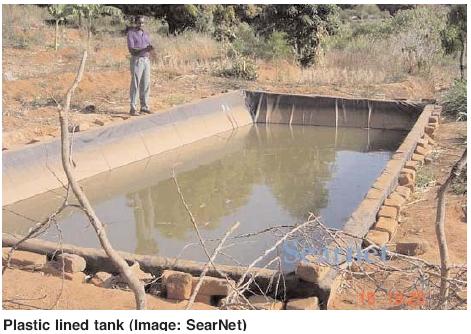Difference between revisions of "Plastic-lined tank"
(→Construction, operations and maintenance) |
(→Suitable conditions) |
||
| Line 12: | Line 12: | ||
==Suitable conditions == | ==Suitable conditions == | ||
| − | Rainwater harvesting requires at least an annual rainfall of 100-200 mm. | + | * Rainwater harvesting requires at least an annual rainfall of 100-200 mm. Depending on the size of the design; the tank has a capacity of 1,500 to 10,000 liter. |
| − | Depending on the size of the design; the tank has a capacity of 1,500 to 10,000 liter. | + | * Shading can reduce evaporation by around 30%. |
{{procontable | pro= | {{procontable | pro= | ||
Revision as of 00:01, 14 April 2012
A low cost alternative to metal or ferrocement tanks for storing of water are plastic-lined tanks. Several models have been developed, for example:
- A cylinder of sheet metal containing a large (eg. 1,500 liter) reinforced plastic bag.
- A plastic liner reinforced with a 10,000 liter plastic bag, installed in a hole in the ground.
Open storage tanks can be made of earth. If clay is not available, a plastic lining is needed to stop water from leaking away. Linings can be made of standard plastic sheet glued together with the tar normally used to repair roofs. The plastic must be covered with earth to prevent it from being exposed to the sun.
The organisation IDE in Asia is developing several models of plastic-lined tanks.
Suitable conditions
- Rainwater harvesting requires at least an annual rainfall of 100-200 mm. Depending on the size of the design; the tank has a capacity of 1,500 to 10,000 liter.
- Shading can reduce evaporation by around 30%.
| Advantages | Disadvantages/limitations |
|---|---|
| - Low cost alternative to metal or ferro-cement tanks. |
Construction, operations and maintenance
Low cost rehabilitation of impluvia with PVC liner in Madagascar by CRS and Practica, has very nice photographs of the process of installing these type of tanks.
Choosing a lining
Plastic/rubber:
A plastic/rubber lining is not an option in most circumstances due to combinations of fragility, expense and feasibility for welding together sheets for larger ponds. Below the pros and cons of various liners are discussed. There are five main types of liner constructions: Polyethylene, Polythylene, PVC liners, EPDM/rubber, and polypropylene. As an indication of costs, an EPDM/rubber sourced in the UK is around $6.5 per square metre not including shipping costs.
Choice of lining needs further consideration:
- Needs to be food grade since the water it stores is for drinking.
- Cost: Polyethylene and Polythylene liners typically cost half that of Polypropylene and EPDM. PVC and PVC-E liners are the next step up from Polyethylene and polyethylene in terms of cost. Compared to other liners, PVC is somewhat more affordable, while being somewhat puncture resistant at the same time but in terms of durability, the typical 20-mil (i.e. 0.020") thick PVC is somewhat mediocre in terms of durability. EPDM is more expensive than Polyethylene, polyethylene, and PVC liners, but can last for up to 20 years. Polypropylene is an expensive material but can last for up to 40 years.
Durability:
- Polyethylene and Polythylene liners typically only last one season.
- Polyethylene will readily conform to any shape, however, it does not have the sturdiness that is required for a permanent pond liner.
- Polythylene, on the other hand, is extremely rigid and can be stiff to work with. Polythylene can be damaged easily by rocks, and has to be handled with care. If polyethylene is damaged, it cannot be seamed together without expensive welding equipment.
- PVC and PVC-E liners are the next step up from polyethylene and polyethylene, and they can last for up to 10 years.
- Polypropylene is an expensive material but it is the most durable pond liner material in existence because it can last for up to 40 years. Polypropylene, however, is not as flexible as EPDM liners.
- EPDM (Ethylene Propylene Diene Monomer) rubber liners are recommended for most pond installations because of their delicate balance between longevity, flexibility, affordability, and their lack of toxic plasticizers. Because EPDM liners are rubber-based, they are extremely flexible (much more so than PVC liners) - the extra flexibility of EPDM comes in handy when working with irregular folds and shelves that are commonly found in a pond. They also do not contain any plasticizers that can make the liner brittle and crack with age. A 45-mil EPDM liner can last for up to 20 years because of its natural resistance to UV, and its puncture resistance.
- Care needs to be taken with cheap linings – in some areas with swelling clay and differential settlement, linings can easily crack. The areas where cheap linings might work therefore may be site-specific, and depend on the clay content of the soil. For plastic linings, experience from India shows that these can be punctured by rodents, crabs or insects if there is no rodent/insect-proof layer before the plastic.
Sheet size:
- Ideally we should not have to weld sheets together in situ.
- The main advantage of polypropylene is that it comes in large sheets larger than 50’ x 100’. If you are building an extremely large pond, polypropylene may be a viable option.
- A limitation of EPDM is its size they typically arrive in sheets ranging from 5’ x 10’ to a 50’ x 100’ roll.
Materials
Material needed for a tank of 5 m3:
- 12 m2 of plastic sheet
- 3 m of PVC tube

